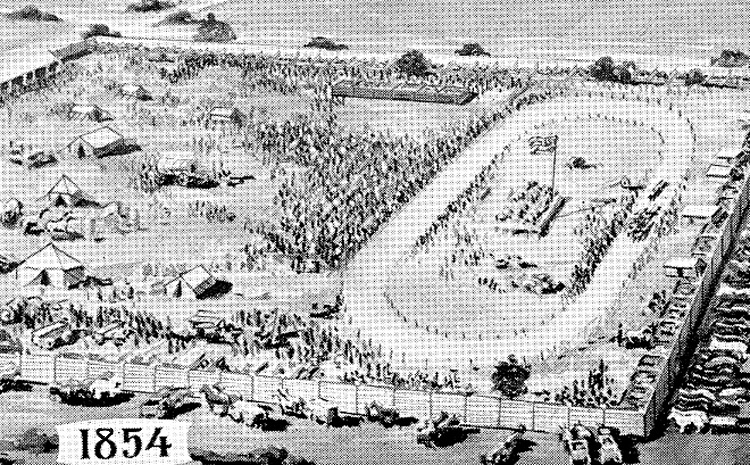
A
crowd around an oval track watching the inaugural state fair in Fairfield in
1854 presents an image reminiscent
of the 1860 state fair held here near what is now the Iowa City airport. Image
courtesy of the State Historical Society.
|
By
Bob Hibbs The
month of October 144 years ago was a highlight during Iowa City’s pioneer
era, bringing crowds for a state fair and a presidential candidate’s visit
that surpassed in size the city’s entire 5,000 population. First
excited fair-goers came Tuesday through Friday, Oct. 2-5, 1860, including
8,000 Thursday afternoon to witness the “roadster class” of thoroughbred
horse races on a half-mile oval dirt track. A grandstand seated about 1,500;
the rest stood or sat on blankets or buggies. At
a time when darkness couldn’t be overwhelmed by artificial light, afternoon
crowds other days also were marked in the thousands. Evening debates at the
courthouse centered on livestock suited to Iowa, not designed to draw crowds. Then,
U.S. presidential candidate Stephen Douglas came Tuesday, Oct. 9, 1860,
lodging at the Crummey House hotel (yes, the owner’s name was Crummey) then
located along the south face of Washington Street midway between present-day
Jefferson Building and Englert Theatre. Democrat
Douglas spoke at City Park before between 4,000 and 15,000 depending on
whether the Republican newspaper estimate is used, or a guess by
Democrat-oriented State Press. City
Park then was a short walk from Douglas’s hotel – in the block now serving
Biological Sciences Building along Iowa Avenue and Van Allen Hall. If
the actual crowd size fell within those extremes, then it was larger than the
entire population of Iowa City, but below the 17,500 of Johnson County. A
48-year-old Douglas spoke in a hoarse voice, explaining that 10 speeches the
previous day had marked a “leisure” campaign schedule during an era before
microphones and amplifiers. Douglas’s
Republican opponent was Abraham Lincoln, who didn’t appear in Iowa City, but
nonetheless outpolled Douglas in Iowa that November 70,000 to 55,000 for
Douglas, with only men allowed to vote before 1920. The
1860 Lincoln-Douglas debates in Illinois, home state to both candidates,
remain legendary today. Iowa’s
earlier state fairs had been held in Fairfield, Muscatine and Oskaloosa; and,
after two in Iowa City the subsequent one visited Dubuque. All
were considered rousing successes, except that of 1861 in Iowa City, dampened
by the Civil War. Then, after 25 years of wondering, the state fair landed
permanently in Des Moines in 1879. Earlier
Iowa City fairs were sponsored by the Johnson County Agricultural and
Mechanical Society. Local fairs began in 1853 on grounds surrounding the Iowa
statehouse, now the Pentacrest Campus around Old Capitol. Like
modern fairs, features then were home-grown fruits, vegetables, flowers and
field crops, incorporating the arts of arrangement and display. Ribbons and
small monetary prizes were numerous, as were exhibits featuring new-fangled
tools, farm machinery and household gadgets – all looking for buyers, of
course. Even
“amber ale” was offered by a Cedar Rapids brewer, and bogus admission
tickets caused a brief stir. Desiring
larger exhibit areas and permanent structures unavailable on Pentacrest, the
county fair society acquired as its home base a 25-acre rural site, now the
southwest quadrant of today’s Highways 1 and 6 intersection in southern Iowa
City. This
site, now serving a shopping center, served the 1860 and 1861 state fairs. Later
the county society purchased 40 acres east of Iowa City – now the
Morningside Drive neighborhood west of present-day City High School. The
present-day fair site is south of the Iowa City airfield. So,
never mind current Iowa visits from President Bush and Sen. Kerry as 2004
contenders for a term as president of the grandest nation on Earth; or the
Iowa football madhouse called Kinnick Stadium. Rather,
think 1860 with huge crowds gathering for a fair; or, for those still
politically awake, a visit from grand orator Stephen Douglas. Do
times change, or are spectacles just recycled using different names and
altered themes? Next
Saturday: A favorite century-old
downtown postcard. Bob Hibbs collects local postcards and other historic ephemera and researches history related to them.
|